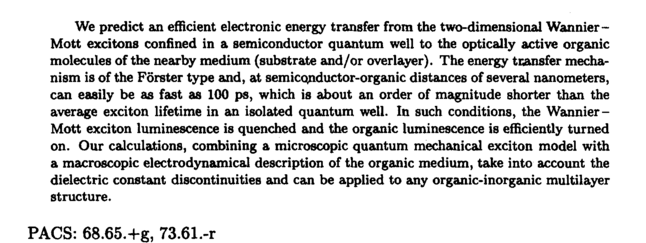|
|

| VOLUME 66 (1997) | ISSUE 11 |
PAGE 714
|
Efficient electronic energy transfer from a semiconductor quantum well to an organic material
Agranovich V.M., La Rocca G.C., Bassani F.
We predict an efficient electronic energy transfer from the two-dimensional Wannier-Mott excitons confined in a semiconductor quantum well to the optically active organic molecules of the nearby medium (substrate and/or overlayer). The energy transfer mechanism is of the Forster type and, at semiconductor-organic distances of several nanometers, can easily be as fast as 100 ps, which is about an order of magnitude shorter than the average exciton lifetime in an isolated quantum well. In such conditions, the Wannier-Mott exciton luminescence is quenched and the organic luminescence is efficiently turned on. Our calculations, combining a microscopic quantum mechanical exciton model with a macroscopic electrodynamical description of the organic medium, take into account the dielectric constant discontinuities and can be applied to any organic-inorganic multilayer structure. PACS: 68.65.+g, 73.61.-r
|
|


